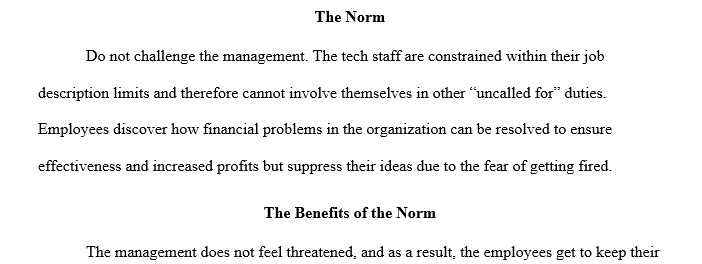Use the questions below as a mental exercise to help you uncover the cultural norms in your organization. What would you tell a trusted friend
1. Use the questions below as a mental exercise to help you uncover the cultural norms in your organization. What would you tell a trusted friend if they told you they were about to go to work at your company and they asked you these questions?
(Not for submission)
1. Who can I trust? What and who should I stay away from?
2. How do different people interact with one another? Different groups? Departments? How do senior leaders interact with middle-level managers and employees?
3. How are conflicts resolved?
4. What issues should I not discuss? What are the topics I should not bring up? What are the sacred cows? What is the elephant in the room?
5. What do people get excited about? What do people get upset about? What types of emotions do people exhibit?
6. Who are the heroes in the company? Who are the villains?
7. What type of people fail at the organization? What type of people thrive?
8. What would you want to change about the organizational culture?
2. Now, identify and analyze three cultural norms in your organization/department. For each norm, identify the benefits of the norm, how the norm came into being and/or is maintained, and the negative consequences of the norm and for whom.
Remember norms drive behavior. Policies are not norms. How people behave with respect to policies are more reflective of a behavioral norm. In fact, the reason you have policies often is to counter cultural norms. If an organization had a well established and agreed upon set of norms that people followed, it would not need written policies. The cultural norms would tell people how to behave in a given situation. So, look below the surface at the actual behaviors, not the policies.
(For submission as a Word document through this dropbox)
Answer the questions below. An example is given to help you craft the answer.
Answer the Questions Below Example Answer
1. What is the norm? Describe it and give an example.
Manage how hard you work. Factory works in the plant limited the amount of production each day so they could get a small bonus but did not work harder to get a bigger bonus.
2. What are the benefits of the norm? Norms only exist because they benefit someone or some group.
Plant employees can take downtime when they want while not attracting management’s attention. They look like they are working hard but could work harder. They don’t want management to know what they are doing for fear that production goals will be raised.
3. How did the norm form? How did it come into existence? What reinforces it?
Management raised the production goals when workers raised their output. New employees that work harder to get a better bonus are quickly told to limit their production.
4. What is the negative consequence of the norm and for whom?
The company could make more revenue and profits with the same number of employees if this norm did not exist.
Answer preview for Use the questions below as a mental exercise to help you uncover the cultural norms in your organization. What would you tell a trusted friend

APA
276 Words